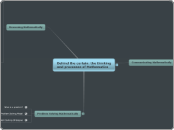Behind the curtain: the thinking and processes of Mathematics
Communicating Mathematically
Math words and symbols
Subtopic
Using data and graphs to communicate
Bar Graphs
Circle Graphs
Using Technology to communicate mathematically
Computer Spreadsheets
Calculators
Types of calculators
4 function
Fraction
Scientific
Graphing
Reasoning Mathematically
Inductive Reasoning
Procedure for using Inductive Reasoning Process
1. Check several examples of possible relationships.
2. Observe that the relationship is true for every example checked.
3. Conclude that the relationship is probably true for all other examples and make a generalization.
Generalization
Counterexample
Patterns
Sequence
Arithmetic Sequences
Geometric Sequences
Fibonacci Sequence
Deductive Reasoning
Statements
Negations
Conditional Statements
Procedure for using Deductive Reasoning Logic
1.Start with a true statement, often in if,then form.
2. Note the given info about the truth or falsity of the conclusion.
3. Use a rule of logic to determine the truth of the conclusion.
Converse
Inverse
Contrapositive
Logical Equivalence
Biconditional Statements
Problem Solving Mathematically
What is a problem?
Problem Solving Model
Problem Solving Strategies
